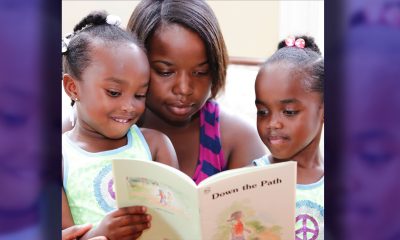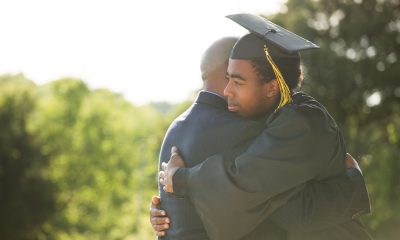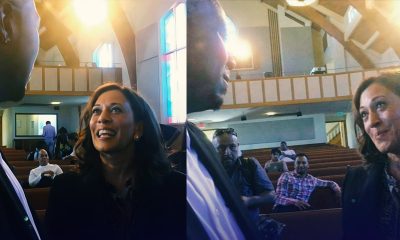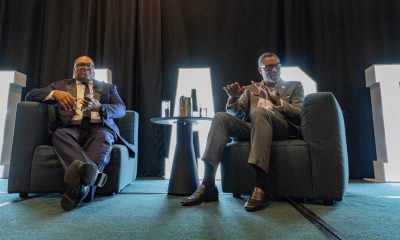Bay Area
The Virus, Vaccines and New Variants: Weighing the Threat of a Mutant COVID Strain
“It is based on a pop-up model. We mobilize with local folks who go door-to-door, hand-to-hand, face-to-face, peer-to-peer, asking questions about COVID. As we moved into the vaccination phase, the Alameda Public Health Department recognized that as a major asset. They knew we could reach people, they couldn’t.”
Health care specialists, including several medical doctors, are keeping their eyes on coronavirus variants that some fear could lead to new strains of COVID-19 that could possibly undermine global efforts to vaccinate people and stem the global crisis.
According to the Centers of Disease Control, the B117 variant (first detected in the U.K.), the most threatening because of its prevalence, is the cause of 20% of new infections in the United States – and 30% of new infections in Florida.
Dr. Nirav Shah, Senior Scholar at Stanford University’s School of Medicine and chief medical officer of Sharecare, a health data services firm, says there are currently four different variants of COVID-19. He said the virus is adapting because “of evolution and natural selection.”
“The more virus particles there are, the more chances that a single virus particle may be a little different than the rest of them,” said Shah. “One or more virus particles is all you need to have a slight change. Maybe these spike protein changes – just a little – and it can attach to cells better than all the other particles.”
Shah said the virus is adapting as it encounters new hosts. But scientists are in a race to get everyone inoculated before the level of the disease in a community gets too high.
The B117 strain, he says, is 50% more infectious than the original strain of the coronavirus and it could lead to up to a 60% to 70% higher rate of death, according to a paper published in the journal Nature.
Shah said some of the COVID-19 virus variants could reinfect people who have contracted the disease before. The good news, he says, is that the B117 is susceptible to existing vaccine therapies, although other variants like 1351 (first detected in South Africa) and P1 (first detected in Brazil), could reduce the effectiveness of the COVID shots in patients.
Fortunately, to date, scientists studying COVID-19 have not identified any variants that have been designated ‘Variants of High Consequence.’ Those in that category “cause more disease and more hospitalizations, and they have been shown to defeat medical countermeasures, like vaccines, anti-viral drugs and mono-clonal antibodies,” says Shah.
Shah was speaking at a recent news briefing on COVID-19 virus variants organized by Ethnic Media Services. Other panelists on the Zoom teleconference were: Dr. Daniel Turner Lloveras, a member of the Latino Coalition Against COVID-19; Dr. Dali Fan, a U.C. Davis Health Science clinical professor and Dr. Kim Rhoads, an African American physician and associate professor of Epidemiology & Biostatistics at U.C. San Francisco School of Medicine.
Although the average citizen may be surprised at how COVID-19 is changing, Fan, said the virus’ adaption and mutation are much like other diseases.
He also presented some statistics from the Center for Disease Control about the coronavirus vaccines and their development. He said the vaccines were tested before they were released to the public.
“All three vaccines are very effective against symptomatic COVID-19,” said Fan. He said there are differences in the content of the vaccines and how they are stored. Fan said the Johnson & Johnson vaccine, which requires one dose, is easier to transport and is perfect for pop-up clinics and rural areas.
“It may be a better option for people who want to get fully vaccinated quickly,” he said.
Turner-Lloveras said that one of the issues overlooked during the coronavirus pandemic is the impact of the digital divide. Black and Latino communities often lag in vaccination rates because they don’t have access to high-speed Internet to discover information and arrange for their vaccination appointments.
“Internet access is a civil rights issue, at this stage,” said Turner-Lloveras. “All of the resources that are provided to people are online.”
He also said more than 20 million seniors don’t have broadband access. “This is a group that needs to be vaccinated, but they don’t have access to the Internet,” he said.
He’s trying to solve this problem with a group called the Digital Companeros, who meet with senior citizens and help them walk through online registration and information. The organization also has a WhatsApp group to target people who access the Internet through their cell phones.
According to Rhoads, some of these reports about Black hesitancy and under-vaccination may not be accurate. She talked about her experiences serving a predominantly African American population in San Francisco through Umoja Health, a coalition of community health organizations that joined their efforts to increase COVID-19 awareness, testing, and vaccinations in Black communities in the Bay Area.
The organization held a mass testing event in the Sunnydale and Bayview Hunters Point neighborhoods in San Francisco where they screened about 400 people, taking a community-based approach she calls “service in the name of public health.” No one came back positive for the coronavirus at a time when there was a 2 % positivity rate in all of San Francisco. She said the people, who were tested by community members, were also eager to get the vaccines. However, she attributes their willingness and openness to their confidence in Umoja Health.
“The community developed rapid trust in us. I was very surprised by this and they called out to us when one community member tested positive,” she said. “We saw neighbors going door to door, knocking telling people to come out and get tested.
“What we recognized from that mass-testing site was that it was not going to work for the African American community,” said Rhoads. “But something more intimate would.”
Rhoads said when African Americans know and trust the health care workers, there is more participation. Because of the organization’s successful testing effort, Alameda County has now entrusted it to provide vaccines in Oakland and areas across Alameda County with African American populations.
“It is based on a pop-up model. We mobilize with local folks who go door-to-door, hand-to-hand, face-to-face, peer-to-peer, asking questions about COVID. As we moved into the vaccination phase, the Alameda Public Health Department recognized that as a major asset. They knew we could reach people, they couldn’t.”
Activism
Oakland Post: Week of November 20 – 26, 2024
The printed Weekly Edition of the Oakland Post: Week of November 20 – 26, 2024

To enlarge your view of this issue, use the slider, magnifying glass icon or full page icon in the lower right corner of the browser window. ![]()
Activism
An Inside Look into How San Francisco Analyzes Homeless Encampments
Dozens of unhoused people are camped at Sixth and Jesse streets in San Francisco’s South of Market neighborhood. Tents made of tarps and blankets, piles of debris, and people lounging alongside the allies and walls of businesses are seen from all angles. These are some of the city’s hotspots. City crews have cleared encampments there over 30 times in the past year, but unhoused people always return.

By Magaly Muñoz
Dozens of unhoused people are camped at Sixth and Jesse streets in San Francisco’s South of Market neighborhood. Tents made of tarps and blankets, piles of debris, and people lounging alongside the allies and walls of businesses are seen from all angles.
These are some of the city’s hotspots. City crews have cleared encampments there over 30 times in the past year, but unhoused people always return.
But it’s normal to have tents set up again within less than 24 hours after an encampment sweep, David Nakanishi, Healthy Streets Operation Center Manager at the Department of Emergency Management, says. Sometimes there’s less people than before but often there is also no change.
“Most of the people that were in the encampments that want to go inside, we’ve gotten the majority of those [into shelter],” Nakanishi says. “Many of the people we encounter now, are those who have various reasons to not accept shelter, and some are already in shelter/housing”.
Since the ruling of Grants Pass by the US Supreme Court earlier this summer, which allows cities the authority to ban people from camping or sleeping on the streets, San Francisco has been at the head of the conversation to crack down on encampments.
Where neighboring cities in the Bay Area are clearing encampments a few days a week, San Francisco is sweeping 10 times a week, two per weekday.

David Nakanishi, Healthy Streets Operation Center Manager at the San Francisco Department of Emergency Management, makes a 311 report on an encampment in the Mission District. These reports allow smaller city teams to tackle individual spots where unhoused people frequent. Photo by Magaly Muñoz.
Considering the controversy that plagues the city around its harsh policies, the Post decided to tag along on a ride with Nakanishi to show us how he decides what encampments make it on the city’s sweep list.
Nakanishi, having over 20 years of experience in homelessness management, drives around the busiest parts of the city almost daily. He’s tasked with arranging a weekly sweeping operation schedule for city teams to engage with unhoused folks to help get them off the streets.
So what exactly is he looking out for when deciding what encampments get swept?
It depends, he says.
Locations like schools, recreational centers, senior centers, or businesses are places he tends to want to address quickly, especially schools. These are the places where the complaints are highest and access to facilities is important for residents.
He says he also takes into account 311 calls and reports made to him by city staff. On the date of publication, over 100 calls and reports were made about encampments around the city, according to San Francisco data.

Makeshift structures built from plywood and tarps are starting to pop up more throughout the city. Certain areas under freeways are not under direct authority from San Francisco, making it harder to sweep these encampments. Photo by Magaly Muñoz.
Nakanishi made a few 311 reports himself on the ride along, pulling over to take photos and describe the encampments into his 311 app. He says it helps him remember where to possibly sweep next or allows smaller teams in the city to engage quicker with individuals on the streets.
Nakanishi also looks at the state of the encampments. Are there a lot of bulky items, such as furniture, or makeshift structures built out of tarps and plywood, blocking areas of traffic? Is trash beginning to pile up and spill into the streets or sidewalks? Sites that meet this criteria tend to be contenders for encampment sweeps, Nakanishi says.
Street by street, he points out individuals he’s interacted with, describing their conditions, habits, and reasons for denying assistance from the city.
One man on 2nd St and Mission, who rolls around a blue recycling bin and often yells at passing pedestrians, has refused shelter several times, Nakanishi says.
People deny shelter for all kinds of reasons, he says. There’s too many rules to follow, people feel unsafe in congregate or shared shelters, or their behavioral and mental health problems make it hard to get them into proper services.

Inside a tent left by an unhoused man on Stevenson and 14th Street in San Francisco. The area smelled of human waste and leftover alcohol. Photo by Magaly Muñoz.
Nakanishi references another man on South Van Ness under the freeway, who city outreach have attempted to get into shelter, but his screaming outbursts make it difficult to place him without disturbing other people in the same space. Nakanishi says it might be an issue of the man needing resources like medication to alleviate his distress that causes the screaming, but the city behavioral team is in the process of outreaching him to figure that out.
In October, city outreach teams engaged with 495 unhoused people. 377 of those engaged refused shelter and only 118 accepted placements, according to city data. That number of monthly referrals is consistent throughout the entirety of 2024 so far.
Nakanishi has long advocated for the well-being of unhoused people, he explains. In 2004, he was working with the Department of Public Health and told then-Mayor Gavin Newsom that there needed to be more housing for families. Nakinishi was told it was easier to deal with individuals first and the city “will get there eventually.” 20 years later, family housing is still not as extensive as it could be, and the waiting list to get placements for families is a mile long with over 500 names.
In 2020, he was a Senior Behavioral Health Clinician at a hotel in the city during the pandemic. He says in 2021 he collaborated with DPH to provide vaccines to those staying in the makeshift hotel shelters once those became available.

Nakanishi strips apart a solo tent on Stevenson and 14th Street in San Francisco. He discards items, like tarps and cardboard, so that people cannot reuse them to make another sleeping structure. Photo by Magaly Muñoz.
Despite the constant media attention that city outreach is inhumanely treating homeless people, so much so that it has led to lawsuits against San Francisco from advocates, Nakanishi says not a lot of people are seeing the true conditions of some encampments.
He describes soiled clothing and tents, drenched in urine, and oftentimes rodents or bug infestations in places where people are sleeping. He’s asked homeless advocates- often those who are the most critical about the city’s work- who have shown up to observe the sweeps if those are conditions the city should allow people to be subjected to, but not many have answers for him, Nakanishi says.
The city’s “bag and tag” policy allows city workers to throw away items that are “soiled by infectious materials” such as bodily fluids and waste.
Sweep operations are conducted at 8am and 1pm Monday through Friday. People at the encampments are given 72 hour notice to vacate, but some don’t leave the area until the day of the sweep.
City outreach workers come out the day before and day of to offer resources and shelter to those interested. The Department of Public Works discards any trash that is left over from the sweep and washes down the area.
Nakanishi told the Post that the only time the city takes tents or personal possessions from residents is when folks become physically violent towards workers and police take the items as evidence. Other items taken are bagged and tagged in accordance with city policy.
Stories from local newspapers such as the San Francisco Standard and the Chronicle show instances of SFPD handcuffing residents while their items are thrown in the trash or disposing of personal possessions without reason.
Advocates have long been pushing for a more competent and compassionate process if the city is going to choose to continue sweeping unhouse people.
No matter the lawsuits and constant criticisms from allies, the encampment sweeps are not slowing down, even with the cold weather quickly approaching the coastal city.
Nakanishi says there aren’t a lot of large encampments left in San Francisco so now they do runs of streets in order to stretch out the sweeps as much as possible.
It’s calculated strategies and years of first hand knowledge that make this job work, “It takes dedication to the work, caring for the people and the community, and persistence, patience and sometimes good luck to make the positive changes for the people on the street,” Nakanishi says.
Activism
Oakland Post: Week of November 13 – 19, 2024
The printed Weekly Edition of the Oakland Post: Week of November 13 – 19, 2024

To enlarge your view of this issue, use the slider, magnifying glass icon or full page icon in the lower right corner of the browser window. ![]()
-

 Alameda County4 weeks ago
Alameda County4 weeks agoAlameda County District Attorney Pamela Price Announces $7.5 Million Settlement Agreement with Walmart
-

 Activism3 weeks ago
Activism3 weeks ago‘Jim Crow Was and Remains Real in Alameda County (and) It Is What We Are Challenging and Trying to Fix Every Day,’ Says D.A. Pamela Price
-

 Bay Area4 weeks ago
Bay Area4 weeks agoIn the City Attorney Race, Ryan Richardson Is Better for Oakland
-

 Activism3 weeks ago
Activism3 weeks agoOakland Post: Week of October 30 – November 5, 2024
-

 Alameda County3 weeks ago
Alameda County3 weeks agoD.A. Price Charges Coliseum Flea Market Vendors in Organized Retail Theft Case
-

 Activism3 weeks ago
Activism3 weeks ago‘Criminal Justice Reform Is the Signature Civil Rights Issue of Our Time,’ says D.A. Pamela Price
-

 Activism3 weeks ago
Activism3 weeks ago“Two things can be true at once.” An Afro-Latina Voter Weighs in on Identity and Politics
-

 Activism2 weeks ago
Activism2 weeks agoLIVE! — TOWN HALL ON RACISM AND ITS IMPACT — THURS. 11.14.24 5PM PST




















































